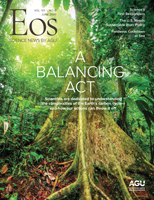The livability of our world depends on a healthy circulatory system for carbon. Knowing how carbon transitions among air, land, and sea is critical to understanding the balance that keeps Earth habitable—not to mention, understanding how our actions can throw off that balance.
In our June issue, several science teams report on work in this area. In “The Future of the Carbon Cycle in a Changing Climate,” Aleya Kaushik and colleagues discuss the complexities of gaining a whole-world view of that cycle. Achieving this holistic view challenges our understanding of how ecosystems respond to climate change and how those responses will alter Earth’s carbon budget in the future. In particular, these predictions are complicated by the numerous feedbacks involved. Kaushik et al. look to the observation networks—both on the ground and orbiting overhead—that have evolved over the past several decades to help scientists address these critical questions.
In “Microbial Influences on Subduction Zone Carbon Cycling,” Donato Giovannelli and colleagues consider the carbon cycle at subduction zones, specifically at the Costa Rica convergent margin. This multidisciplinary team was part of a Deep Carbon Observatory project called Biology Meets Subduction, which was aimed at answering several questions about the influence of biological activity at the convergent margin and, ultimately, determining whether the team could use that information to improve deep-carbon budget estimates for the area. Like all the best research, their work is yielding promising data and raising many more intriguing questions.
In this month’s news, we report on a fascinating experiment at a geothermal facility in Iceland. Carbon storage trials are showing that 90% of carbon dioxide injected into subsurface basalt rock is transformed into minerals in just 2 years, whereas mineralization in standard carbon storage methods can take thousands of years. Head to “Basalt Turns Carbon into Stone for Permanent Storage” to read more about the potential of mineral carbonation as a means of large-scale carbon sequestration in Iceland and elsewhere and whether it’s up to the task of making a measurable impact on climate change.
On the other side of the carbon cycle, a recent study shows that mountain streams, though comprising only about 5% of the surface area of rivers and streams globally, might account for 10% to 30% of the total flux of carbon dioxide from those waterways. Scientists have also recently discovered that the Arctic Ocean may not be as important a carbon sink as previously thought.
Finally, we’re pleased to share an article from the editor in chief of one of AGU’s newest journals, GeoHealth. Gabriel Filippelli writes in “Geohealth: Science’s First Responders” about how geoscientists, health professionals, and regional leaders are growing into a new community that is combining and harnessing their skills to address disasters. Looking back at the Deepwater Horizon disaster and the Tohoku earthquake and tsunami, Filippelli examines lessons learned from those events and how we should be applying them to the current global pandemic.
Our June issue examines the balance of this planet’s systems and, in so many ways, how anthropogenic forcing can step on that balance. How can we assess the natural movements of carbon while we keep pumping carbon into the air? How can we prepare to live safely in a world where disasters, even relatively predictable ones, can still be sudden and overwhelming? The scientists featured in this issue are committed to answering those questions and, ultimately, to making our world more knowable so we can better prepare ourselves for change.
—Heather Goss (@heathermg), Editor in Chief
Citation:
Goss, H. (2020), A whole world view, Eos, 101, https://doi.org/10.1029/2020EO144416. Published on 21 May 2020.
Text © 2020. AGU. CC BY-NC-ND 3.0
Except where otherwise noted, images are subject to copyright. Any reuse without express permission from the copyright owner is prohibited.


